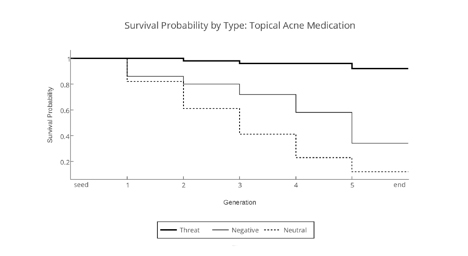
Here is an interesting paper from a journal called, Evolution and Human Behavior. The study is entitled, Origins of sinister rumors: A preference for threat-related material in the supply and demand of information written by Timothy Blaine and Pascal Boyer. It is a behavioral study using paid volunteers from Amazon’s Mechanical Turk. It is split relatively evenly with respect to gender and tends to be more Caucasian (80%). It also looks at a small number of participants, so all the usual caveats regarding these types of studies apply. That said, it presents an intriguing notion and “explains” some of our behavior.
The authors developed several, paragraph-long descriptions of products, (hair dye, running shoes, and acne medication) that contained two sentences describing a threat or what we would call a risk, two sentences describing a negative quality and four sentences that were neutral concerning threat or negativity. In an electronic version of our childhood game of telephone [1], they then asked 25 volunteers to read the paragraph and choose the seven most salient sentences to share with another. These seven sentences were then given to the next 25 volunteers who selected the six most salient sentences, and so on. To assure that the material was being read, the researchers eliminated any volunteer who could not recall the name of the product. They repeated this process for five cycles.
They found that threats (risks) were transmitted more than negative statements and much more than neutral comments. Here is a typical graph of their findings:
 They repeated the study but altered the threat statement to be more explicitly a low risk, either by saying it was ‘rare’ or by providing a small percentage, 2%. Once again, threat statements survived the longest although the difference in retention of negative and neutral comments diminished.
They repeated the study but altered the threat statement to be more explicitly a low risk, either by saying it was ‘rare’ or by providing a small percentage, 2%. Once again, threat statements survived the longest although the difference in retention of negative and neutral comments diminished.
A third variation was a more realistic version of our everyday conversations introducing some positive statements, using words, “can almost always” or a number, 95%. Threat information was again the most transmitted, although positive statements were a close second. The authors concluded that people deliberately transmit threat information, even when it has a low probability and at rates comparable to the transmission of far more likely positive information. People demonstrated a “willingness to supply threat information.”
But if this threat information was supplied, was there a demand for this information over negative, neutral or positive statements. They asked participants, using those same eight sentences whether they would like more information. 63% of the time people wanted more details about those low probability threats, additional details about negative or high probability positive information was requested 38% and 34% respectively. So, on both the supply and demand side low probability threats were the focus of communication.
The authors noted that they looked only at physical rather than social risks and that their transmission chains were linear and did not adequately model the more diffuse way information is shared with us through multiple paths. Here is their conclusion:
“Such selective preference may contribute to explaining the cultural spread of rumors, myths, and urban legends that prominently feature danger as a narrative component but often describe very rare or peculiar events. … it seems that these low-value missives continue to circulate not because of their usefulness, but because there is some motivation to share threats as relevant information…. Why do people prefer to share threat information? The studies presented here document this deliberate preference but do not elucidate motivations for this behavior. Previous studies have shown that sources are perceived to be more competent when they share threat information than when they share non-threatening negative information … If that is a valid observation, then we would expect some people to convey information about dangers, as to appear competent and therefore valuable contributors to knowledge. But that is unlikely to be the sole factor in the general preference for threat-information.” [Emphasis added]
Could it be that the plethora of media reports of low-risk threats is more about appearing as competent, purveyors of valuable information than about providing information in a useful context? We write about these types of reports every day. It would be a comforting belief that the disseminators of such articles and stories have no ill-intent and that it is a “lizard brain defense system” that biases them towards reporting low-probability risk.
[1] Perhaps I am assuming too much of my childhood game. In telephone, you whisper a message to the person next to you who in turn whispers it to the next person. At the end of the line, the last person says the message they heard aloud. It is always different than how it began.



